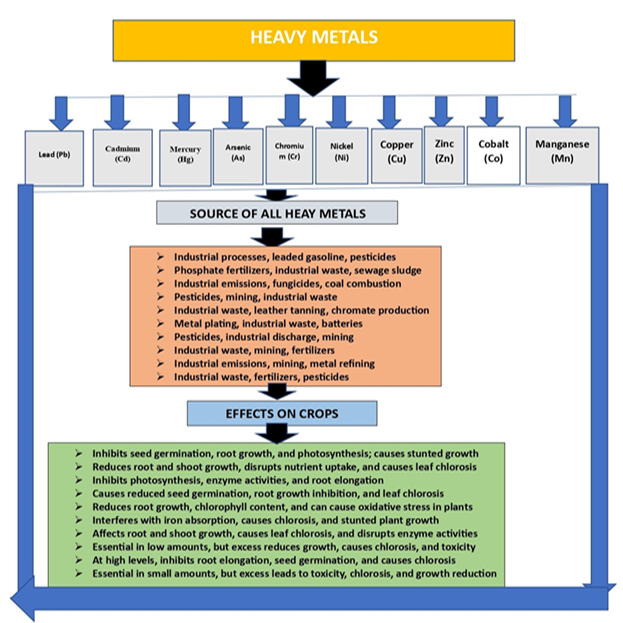SECURING 2050
As we look towards a future where the global population is projected to reach 9.1 billion by 2050, the challenge of ensuring food security becomes increasingly critical. Among the many threats to agriculture, heavy metal contamination in soil stands out as a formidable adversary. Heavy metals such as cadmium (Cd), lead (Pb), mercury (Hg), and arsenic (As) pose severe risks to crop health, productivity, and human safety. In response, innovative breeding technologies, including genomics, ionomics, omics sciences, artificial intelligence (AI), robotics, and computer vision, are being harnessed to combat this peril and protect our food supply.
The Menace of Heavy Metals in Agriculture
Heavy metals, defined by their high density and toxicity even at low concentrations, can severely impair plant growth and development. These elements, including cadmium, lead, and mercury, interfere with essential physiological processes in plants, leading to reduced energy production, impaired nutrient and water uptake, and the generation of harmful reactive oxygen species (ROS). The accumulation of ROS damages plant DNA, proteins, and cell membranes, ultimately decreasing crop yield and quality. Heavy metals also persist in the soil for decades, posing long-term threats to agriculture and food safety.
Advanced Breeding Technologies: A Beacon of Hope
Genomics and Omics Sciences
Genomics, the study of an organism’s complete set of DNA, is at the forefront of breeding technologies aimed at enhancing crop resilience to heavy metals. By identifying and mapping genes associated with heavy metal tolerance, scientists can develop crop varieties that are not only resistant to heavy metals but also capable of thriving in contaminated soils. This genetic roadmap guides breeders in selectively incorporating these traits into new crop varieties, ensuring that they can withstand and mitigate the effects of heavy metals.
The integration of omics sciences—transcriptomics, metabolomics, proteomics, and ionomics—provides a holistic understanding of how plants respond to heavy metal stress. Transcriptomics reveals how genes are expressed under heavy metal stress, while metabolomics examines the biochemical changes in plants exposed to these toxins. Proteomics focuses on the proteins affected by heavy metals, and ionomics studies the elemental composition of plants in various environments. Together, these disciplines offer comprehensive insights into the molecular mechanisms underlying heavy metal tolerance, informing targeted breeding strategies.
Artificial Intelligence and Robotics
Artificial intelligence (AI) is revolutionizing agriculture by enabling the rapid analysis of vast datasets generated by genomics and omics sciences. Machine learning algorithms can predict how plants will respond to different heavy metals and identify key genetic markers associated with tolerance. AI-powered models also facilitate the optimization of breeding programs, accelerating the development of resilient crop varieties.
Robotics and automation play a crucial role in precision agriculture. Advanced robots equipped with sensors and computer vision technologies can monitor soil and plant health in real-time, detecting early signs of heavy metal stress. These robots can also assist in the precise application of fertilizers and soil amendments, minimizing the risk of heavy metal uptake by crops.
Success Stories: Combatting Heavy Metals
Several success stories highlight the potential of advanced breeding technologies in addressing heavy metal contamination. For instance, scientists have developed rice varieties with enhanced tolerance to cadmium, a heavy metal that can easily accumulate in rice grains, posing significant health risks to consumers. By leveraging genomic tools and marker-assisted selection, researchers identified key genes responsible for cadmium uptake and bred rice varieties that limit cadmium accumulation in edible parts.
Similarly, advances in phytoremediation—using plants to remove contaminants from the soil—have been achieved through genetic engineering. Researchers have created genetically modified plants capable of hyperaccumulating heavy metals like lead and arsenic, effectively cleaning up contaminated soils while producing safe, high-yield crops.
The Path Forward: Ensuring Food Security
As we move towards 2050, ensuring food security for a growing global population requires a multifaceted approach. The integration of genomics, omics sciences, AI, robotics, and computer vision technologies offers a promising pathway to developing heavy metal-resistant crops and sustainable agricultural practices. However, this effort must be supported by robust policies and international collaboration to address heavy metal contamination comprehensively.
Raising Awareness: The Role of Public Engagement
Public awareness and engagement are crucial in the fight against heavy metal contamination. Understanding the sources and impacts of heavy metals on agriculture and food safety empowers communities to advocate for sustainable practices and policies. Educational campaigns, community workshops, and media outreach can play a vital role in disseminating information about the dangers of heavy metals and the innovative solutions being developed to combat them.
Conclusion
The battle against heavy metal contamination in agriculture is a critical component of ensuring food security for future generations. By harnessing the power of advanced breeding technologies, genomics, omics sciences, AI, robotics, and computer vision, we can develop resilient crop varieties and sustainable agricultural practices that protect our food supply. As we strive towards a future where 9.1 billion people have access to safe and nutritious food, the importance of innovative and collaborative efforts cannot be overstated. Together, we can overcome the challenges posed by heavy metals and secure a bountiful harvest for all.
(Author is scientist – MRCFC- khudwani, SKUAST- Kashmir. Feedback:[email protected], [email protected]. Visiting Scientist, University of Nebraska Lincon, USA)








